Matador Network's Blog, page 506
March 28, 2022
Hardest languages to learn

With a lot of effort and passion, English speakers can learn any languages, but some are definitely more difficult to master than others.
The US Foreign Service Institute (FSI), a branch of the US government that trains officials before they are sent to work abroad, knows all about the difficulties involved in teaching English speakers a foreign language. After teaching languages to US diplomats for 70 years, the people at the FSI have drawn from their experience and created a list of the hardest languages to learn for English speakers. The list is divided into “hard languages” and “super-hard languages”.
The FSI defines “hard languages” as “languages with significant linguistic and/or cultural differences from English.” “Hard languages” require an average of 44 weeks of training, i.e. 1100 class hours, to reach proficiency.
“Super-hard languages” are explained to be “languages which are exceptionally difficult for native English speakers.” The FSI estimated the average length of time for a student to achieve proficiency in a “super-hard language” is around 88 weeks, AKA 2200 class hours. It is double the amount of time believed to take to learn a “hard language.”
The list of seven languages below consists of a mix of “super-hard” and “hard” languages and is not exhaustive (there are, after all, more than 5,000 languages spoken in the world today), but they are some of the hardest languages to learn for English speakers.
Hardest language to learn #1: ArabicArabic is considered a “super-hard” language by the US Foreign Service Institute.
Arabic breaks down into families. One is the Modern Standard Arabic of print, media, and online content. The other is spoken Arabic, which encompasses many dialects which vary by region. This means that if you pick up conversational Arabic in Tunisia, it might still be tough to be understood in Kuwait.
For all dialects of Arabic, pronunciation is difficult for English speakers, as many consonants are formed at the back of the mouth.
Arabic script is a phonetic, 28-symbol alphabet descending from Phoenecian. Most letters change shape depending on their position in the word, and letters may or may not be joined. The most basic challenge in tackling written Arabic is in reading from right to left, working against an English speaker’s deeply embedded instinct.
Arabic grammar has very few parallels with English and Indo-European languages. The plural is expressed by changing the vowel structure of the word: kitab (book) becomes kutub (books). The bulk of verbs are irregular and can be formed 25 ways.
For a taste of Arabic, check out Matador Network’s “8 Idioms Only Arabs Understand.”
Hardest language to learn #2: CantoneseCantonese is considered a “super-hard” language by the US Foreign Service Institute.
Cantonese is a tonal language, which can be very challenging for English speakers who are used to speaking with emphasis (“I didn’t eat YOUR sandwich!”) and inflection, i.e rising tones to pose a question. Cantonese can be difficult even for those fluent in other Chinese dialects because of its tonal system. While Mandarin has four tones, Cantonese has six, with pitch and contour shaping a syllable’s meaning.
Cantonese has a logographic (pictoral) writing system of thousands of characters. This gives a new hurtle to language learning, since a reader of Cantonese can’t sound out syllables in a text as we can with phonetic alphabets. They must know and recall the name of each character. It is a myth that all Chinese languages are written in the same logographic form, though Cantonese and Mandarin share many traits of their writing systems, and the Mandarin writing system is often used by Cantonese speakers.
Read “I Haven’t Spoken Cantonese for 30 Years. Here’s What Happened When I Tried To Speak It Again” on Matador Network.
Hardest language to learn #3: JapaneseJapanese is considered a “super-hard” language by the US Foreign Service Institute.
The good news about Japanese? For English speakers, pronunciation is a cinch. Japanese vowel and consonant sounds are very familiar to those fluent in English, which makes the language easy to parrot and understand.
The tough part? Written Japanese can be a headache to learn. It uses four alphabets including the Chinese-influenced kanji (pictoral), two phonetic writing systems, and the Roman alphabet (Romanji).
The notion of honorific language is challenging for learners. Japanese speech can vary with levels of politeness, with each level having set forms and rules. English has no set way of speaking honorifically or intimately, and learners may have trouble recalling when and where to use honorific speech.
Grammatically, Japanese is a mixed bag. There are only three irregular verbs and a pretty consistent structure, with verbs at the end of the sentence. Nouns carry no gender or number, though they can function as adjectives or adverbs, which can be confusing for readers.
To learn more about the Japanese language, check out Matador Network’s “30 Awesome Japanese Idioms We Should Start Using in English.”
Hardest language to learn #4: MandarinMandarin is considered a “super-hard” language by the US Foreign Service Institute.
Written Mandarin is pictoral and contains over 20,000 characters. Some base characters, like root words, appear in other symbols, like the character for “woman” forming part of “sister.” The written form of the language has no phonic connection to the spoken form.
Mandarin, like Cantonese, is a tonal language, and a misused inflection can change the meaning of a sentence. The syllable “ma” can mean mother or horse, depending on the inflection, which could lead to grave insults at the dinner table.
Grammatically, Mandarin is far simpler than Indo-European languages. Words, for the most part, have only one grammatical form. Their function is shown through prepositions, word order, and particles. Building and comprehending this syntax, however, takes time. There are some tough elements like Mandarin adverbs: a dozen words which have no direct English translation.
Read “Mandarin Is Both Incredibly Hard and Ridiculously Easy To Learn. Here’s What Travelers Can Master” on Matador Network.
Hardest language to learn #5: KoreanKorean is considered a “super-hard” language by the US Foreign Service Institute.
At first, the language seems far easier than other East Asian tongues — there are no tones and no pictoral writing system.
It’s true that reading and writing in Korean is easy to master, as the language uses the very logical Hangul phonetic writing system. Speaking and listening, while tone-free, can be challenging with unique sounds that are hard for English speakers to recognize, let alone master.
The biggest challenge with Korean lies in the grammar. Verbs can be conjugated in countless ways, depending on tense, mood, age, and seniority. Like Japanese, one sentence can be said in three different ways, depending on the relationship between the speaker and addressee. Adjectives are conjugated too, with many possible endings. Also, there are also two different number systems, quite different from one another.
For a taste of Korean, read Matador Network’s “The 14 Funniest Korean Expressions (and How To Use Them).”
Hardest language to learn #6: FinnishFinnish is considered a “hard” language by the US Foreign Service Institute.
Barry Farber, the author of How to Learn any Language and a polyglot many times over, says that Finnish is one of the hardest languages for him to learn.
Finnish is in the Finno-Ugric language family, with Estonian and Hungarian. Without Germanic or Latin influence, Finnish vocabulary is completely alien to English speakers. Its grammar is also somewhat notorious. There are fifteen noun cases, sometimes with subtle differences. Talotta means “without a house,” while talolta means “from a house.” Tricky.
There are six verb types, classed by their stems. These stems alter as the verbs are conjugated. The language is agglutinative and verbs are conjugated with a succession of suffixes.
The good news? Finnish is written as it sounds (in the Roman alphabet), and pronunciation is comfortable for English speakers. A common speaking problem lies in remembering single or double vowel sounds, as in tuli (fire) and tuuli (wind).
Read “What the Finnish Concept of Sisu, or Inner Strength, Can Teach Us” on Matador Network.
Hardest language to learn #7: HungarianHungarian is considered a “hard” language by the US Foreign Service Institute.
Though it uses the Roman alphabet for writing, don’t think that reading Hungarian will be a snap. Unique vowel sounds (á, é, ó, ö, ő, ú, ü, ű, í) and consonant clusters (ty, gy, ny, sz, zs, dzs, dz, ly, cs) make it difficult for English speakers to read and pronounce Hungarian.
Instead of articles, Hungarian conjugates verbs in one of two ways for definite and indefinite objects. Olvasok könyvet means “I read a book,” while Olvasom a könvyet is “I read the book.”
Because possession, tense, and number are indicated by suffixes, not word order in a sentence, Hungarian sentence structure is very loose and flexible. And while this may sound forgiving for a novice speaker, the truth is that any sentence can take on several meanings if the suffixes are altered slightly.
Learn more about the Hungarian language by checking out “The 17 Funniest Hungarian Expressions (and How To Use Them)” on Matador Network. 
A version of this article was previously published on February 24, 2011, and was updated on March 28, 2022.
More like thisLanguages9 Easy Languages for English SpeakersWatch: An Inside Look at the High Quality of Life You Can Have Coliving in Costa Rica
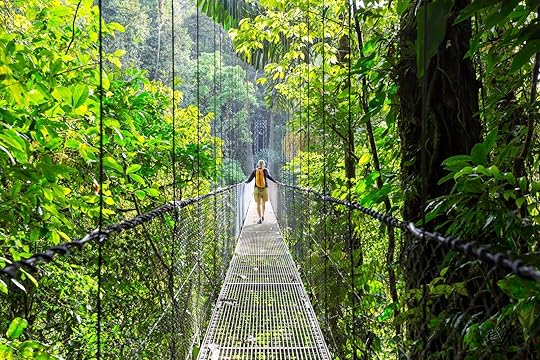
Co-living is a great option for both seasoned digital nomads and newbies who want to live and work remote. Co-living allows for a unique opportunity to walk into a built-in community, which can be useful when you plan on planting roots (even if only temporarily). And when it comes to places to do that, few match up to Costa Rica.
@waleedtravels Day in the life working remote in Costa Rica#remote #digitalnomad #fyp #travel #traveltok ♬ Paradise – Ikson
With its lush forests and slow pace, Costa Rica has a lot to offer — something immediately clear from Waleed Maoed’s TikTok explaining a day in the life since he moved into a Selina co-living community in La Fortuna, Costa Rica.
Maoed seems to be living every digital nomad’s dream. Starting his day with some wellness, then getting some stretches and a healthy breakfast in before heading to work in the beautifully designed co-working part of the property. While he’s working, he stops to head into town and grab a smoothie for just $1. But the real fun happens after work when it’s time for some adventure. Maoed heads to El Salto, a rope swing over a body of crisp blue water, followed by some relaxing time in the natural hot springs. Once he returns to the property, he sits by the firepit for a while before heading to the gym, and finally sets his sights on somewhere to get a tasty dinner.
It’s amazing how much productivity combined with adventure you can get all in one day. Who says you can’t mix business with pleasure? Maoed is taking advantage of a coliving company called Selina, where you can sign up to live on one of their properties around the world for a monthly fee. The company works with your budget to offer everything from shared dorm living to private suites. Membership gets you accommodations, co-working access, wellness classes, access to the online community, onsite discounts and more. Their packages also give you the option to hop in between properties, so you can have accommodations wherever you go.
Costa Rica is a great option for digital nomads as it just launched its digital nomad visa, which makes it easier than ever to live in the country for two years. If you’re not interested in living in Costa Rica in a co-living community, there are plenty of other ways to move to Costa Rica cheaply. 
The Best Airbnbs in the Scottish Isles for Whiskey Enthusiasts

Scotland’s western islands beckon intrepid explorers with a penchant for wilderness and a nose for whiskey. Known for its peaty blends, the Isle of Islay is the beating heart of the Scottish whiskey scene although distilleries on neighboring islands wrestle for their share of attention. Here’s our pick of remote cabins, boutique Islay cottages, and unique Airbnbs in the Scottish Isles for whiskey enthusiasts.
Best Airbnbs on IslayBest Airbnbs on HarrisBest Isle Arran AirbnbsBest Airbnbs on OrkneyBest Isle of Skye AirbnbsWe hope you love the Scottish Isles cottage rentals we recommend! Just so you know, Matador may collect a small commission from the links on this page if you decide to book a stay. Listed prices are accurate as of the time of publication. See our full Advertiser Disclosure here.
Best Airbnbs on IslayThe Old Byre Islay cottage
Photo: Airbnb

Photo: Airbnb

Photo: Airbnb

Photo: Airbnb
Straight out of a fairytale, this whitewashed home is representative of Islay cottages set within a private garden where you can welcome the summer rays and watch the free-roaming hens, guinea fowl, and peacocks. When rain strikes, the property’s vast collection of board games and books will keep you entertained. Special touches at your self-contained holiday home include a blazing log-burner, a countryside-chic kitchen, and a roll-top bath. Situated 4 miles outside of Port Charlotte, you have three distilleries on your doorstep.
Two guests, one bedroom
Price: $130 per night

Photo: Airbnb

Photo: Airbnb

Photo: Airbnb

Photo: Airbnb

Photo: Airbnb
Maroon yourself in this postcard-pretty cottage near the heritage village of Port Charlotte with views of the rippling sea. The front lawn stretches down to the newly installed lighthouse path which guides you to the lovely beaches and coves of Loch Indaal. Although fabulous for walking, the route is even better explored with the help of a rental bicycle. Bruichladdich – known for its citrusy single malts and dry gins – is your nearest distillery. Grab a bottle to savor among the blooms in the private garden or in front of the open fireplace. With a double and a twin room, this humble cottage is a solid choice for outdoorsy families.
Four guests, two bedrooms
Price: $130 per night

Photo: Airbnb

Photo: Airbnb

Photo: Airbnb
Situated in the RSPB reserve at Loch Gruinart in northern Islay, the only souls you’ll see during your stay at this luxury vacation rental have feathers and wings. The expansive home features a games room with table football and table tennis as well as an artist’s studio to stir up your creative juices. A state-of-the-art kitchen equipped with an electric Aga awaits traveling chefs eager to experiment with whiskey-based stews. Take a soak in the free-standing bathtub or indulge in a leisurely sauna session to keep the frostbite away.
Twelve guests, five bedrooms
Price: $280 per night

Photo: Airbnb

Photo: Airbnb

Photo: Airbnb

Photo: Airbnb
The two-bedroom Aird Villa occupies a prime seaside setting on the Isle of Scalpay off the magnificently rugged Harris. This far-flung island fuses together all the draws of the Outer Hebrides: whiskey, wilderness, and wildlife watching. Make yourself at home on the ample terrace as fishing boats bob in the harbor beneath you. The interiors are bright and roomy with large windows to capitalize on the scenery. Each bedroom has a private bathroom which makes the villa a top choice for a small group or a pair of couples.
Four guests, two bedrooms
Price: $210 per night

Photo: Airbnb

Photo: Airbnb

Photo: Airbnb
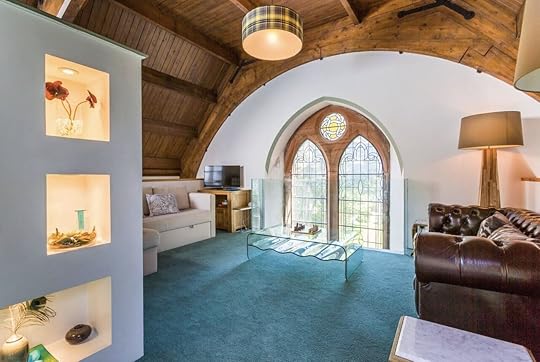
Photo: Airbnb
Touted as “Scotland in miniature” Arran is an amalgamation of Scotland’s best bits. Suitable for a couple or a pair of couples, this unconventional holiday home is a renovated Scottish Free Church. While remaining faithful to the original architecture, the space has been innovatively remodeled to feel like a modern-day home away from home. Besides the arched windows, stained glass, and even a church pew, the house features a “floating” mezzanine and plush contemporary furnishings. Subject to the weather, you can bask in the spacious garden or hole up in the conservatory with a tumbler of single malt from the nearby Lochranza Distillery.
Four guests, two bedrooms
Price: $140 per night

Photo: Airbnb

Photo: Airbnb

Photo: Airbnb

Photo: Airbnb
Built by Captain Patterson in 1770, this stately pad is one of the oldest buildings on the island. Hefty renovations have brought the interiors up to scratch while maintaining a nod towards the heritage of the building. Three en-suite bedrooms grant killer views from bay windows while original fireplaces have been updated with neat wood burners. A generous lawn unravels from the estate and provides uninterrupted views of the ocean. And best of all: this top-tier mansion in Whiting Bay is pet-friendly.
Eight guests, three bedrooms
Price: $530 per night

Photo: Airbnb

Photo: Airbnb

Photo: Airbnb

Photo: Airbnb
To good health! That’s the ethos behind “Slainte Mhath” – a typical Scottish toast and this premier vacation rental in southwest Arran. The secluded bungalow overlooks Holy Isle and is a short drive from Lamlash where you can hop aboard a boat and explore the island. Enthusiastically decorated with locally produced arts and crafts, the home comes with a pool table as well as a deluxe hot tub on the deck. Equipped with three bedrooms and settees-a-plenty, you can’t find a better base for a group or family trip to Arran.
Eight guests, four bedrooms
Price: $265 per night

Photo: Airbnb
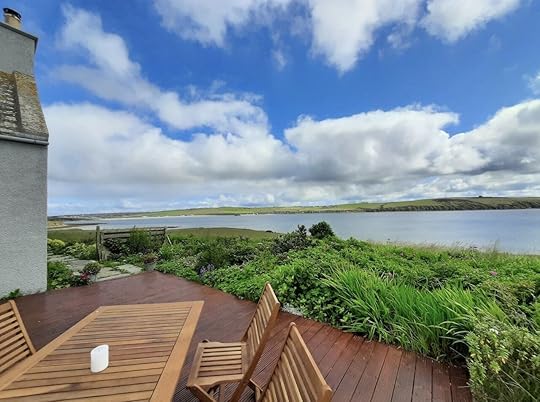
Photo: Airbnb

Photo: Airbnb

Photo: Airbnb
Carefully renovated for modern tastes, this superb two-bedroom cottage in the Orkney archipelago retains its 19th-century charms. Fashionable interiors are flooded with natural light and endless ocean vistas. Hop out onto the deck to find the star attraction – a private wood-fired hot tub. Keep walking and you’ll have direct access to paddle boarding, wind surfing, and kayaking. Although it feels pleasantly off-grid, you’re a short drive from Scapa and Kirkwall where you’ll find whiskey distilleries aplenty.
Four guests, two bedrooms
Price: $260 per night

Photo: Airbnb

Photo: Airbnb

Photo: Airbnb
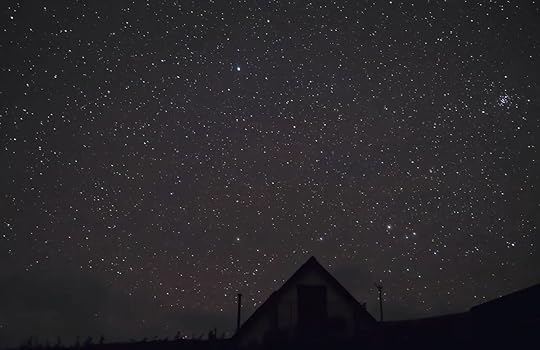
Photo: Airbnb

Photo: Airbnb
Basking on the outlying Waternish peninsula with panoramic views across Loch Snizort and the Ascrib islands, Eagle’s Rest is a dreamy hideaway for couples. This cottage near Hallin features an open-plan kitchen, diner, and lounge. The bedroom comes with a balcony and cleverly positioned skylight above the bed where you can make the most of the setting in an official Dark Sky Reserve. Cross your fingers and you might catch a glimpse of the Aurora Borealis during the winter months while sipping your glass of Talisker.
Two guests, one bedroom
Price: $205 per night

Photo: Airbnb

Photo: Airbnb

Photo: Airbnb

Photo: Airbnb
Suitable for small groups or honeymooners, this stylish property with spa amenities is akin to booking a wellness escape. Minimalist interiors are curated with bespoke Harris Tweed soft furnishings and neutral hues to lull you into tranquility. Bose smart speakers in the swanky kitchen and lounge when you fancy a change from the sound of the waves outside. The highlights of this luxury cottage in northwest Skye are the Swedish sauna and external hot tub where you can relax and revitalize beneath the stars. There are far worse places to recover from a long night of whiskey tasting.
Four guests, two bedrooms
Price: $460 per night

Photo: Airbnb

Photo: Airbnb

Photo: Airbnb

Photo: Airbnb
This recently renovated 19th-century Nordic-style house sits on a bluff overlooking the coast near Glendale. An expansive sunroom is heated with a log burner to keep you toasty while the telescope is on hand for an evening of stargazing. Lap up the views from the external Swedish log-fired hot tub and keep your eyes peeled for the resident dolphin pod. This faraway haven is the answer for families and groups seeking a restful retreat in the pristine Scottish landscape.
Five guests, two bedrooms
Price: $400 per night

Photo: Airbnb
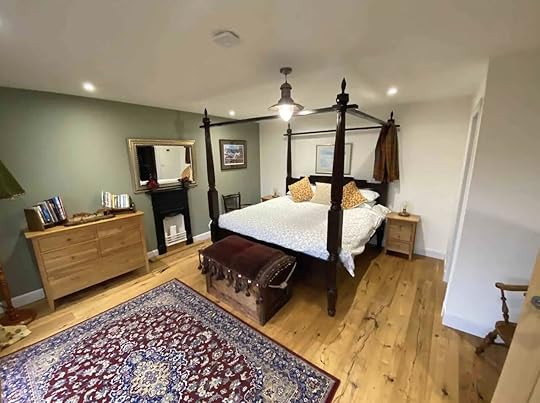
Photo: Airbnb

Photo: Airbnb

Photo: Airbnb
This secluded cottage comprises a generous kitchen and lounge area with a snuggly nook for film nights – or cycling your way through the extensive CD collection. Besides one double and one twin room, there is a sofa bed on the mezzanine. Spend days exploring the local hiking trails and waterfalls then slip – whiskey in hand – to the wood-fired hot tub for a spot of stargazing. The host offers attractive long-stay discounts that might inspire you to catch yourself away to the Scottish Isles for good.
Six guests, two bedrooms
Price: $400 per night
Camping Mistakes: 8 Things You Should Never Do at a Public Campground

If you’re getting ready for summer camping trips, you’re probably already deep into planning, especially if you’re going to a national park. Most national park campground reservations open about six months ahead of time on Recreation.gov, so now is prime time for snagging those reservations and ensuring your various park permits are in order (looking at you, Angel’s Landing).
Camping in a campground doesn’t have to be expensive or difficult and provided the weather is passable, there’s no need to spend hours searching online for expensive tents or sub-zero sleeping bags.
Instead, you should spend that time brushing up on your camping etiquette — what to do and, equally important, what not to do when you’re sleeping just a few feet from strangers. Some of the recommended camping etiquette below is just about being polite to your fellow campers, while some are seriously important. In fact, some of these tips will be printed on your camping permit since failing to obey them could result in major fines (or even jail time), like making a fire when they’ve been banned.
Even first-time campers will look like total pros if they follow these simple suggestions. Ignore this camping etiquette and, well, don’t be surprised if your fellow campers shoot you some angry looks when you walk by.
Without further ado: eight things you should never do at a public campground (unless you want to have an angry park ranger show up at your tent).
1. Not properly putting out your fire
10/10 for style; 1/10 for proper campfire extinguishing. Photo: Aleksey Boyko/Shutterstock
Failing to properly extinguish your fire is probably the most serious faux-pas on this list, and it has serious consequences. Wildfires started by campfires have caused millions in damages, destroyed homes, killed wild animals, and decimated entire swaths of mountain ranges in the American West. And if you’re thinking, “I’d never fail to extinguish my fire,” well, that’s great — but are you doing it properly? It’s about more than just dumping water on top.
You need to flatten the fire and make sure all sides of every log are soaked, lest a hidden ember brings the whole fire roaring back to life an hour later. You’ll want to use your fire prod to “stir” the coals and ashes, ensuring that absolutely nothing is still burning. You should always try to extinguish your fire at least 30 minutes before turning in so you have plenty of time to re-douse it if you missed a spark.
2. Leaving food and food scraps out
I’m no mammalogist, but I’m pretty sure a squirrel’s natural diet doesn’t include too many Quaker Oats oatmeal raisin granola bars. (I think squirrels prefer chocolate chip.) Photo: Wirestock Creators/Shutterstock
Newsflash: just because you’re not in bear country doesn’t mean you can leave food out. Squirrels and mice are attracted to food and since mice tend to chew holes in nearly everything, it’s always best if you don’t attract them to campgrounds.
Even in areas without small critters, birds can make a huge mess of any food left out, and you’d be surprised how quickly an entire army of ants can show up if you drop a marshmallow. It may seem like it’s no big deal since food will decompose, but it seriously screws with the food chain and can put animals in jeopardy — bears that show up too often in campgrounds are often euthanized. But if you leave food out, a bear is going to act like a bear. So be a good neighbor to your fellow woodland, farmland, or dessert denizens, and put food away quickly and appropriately in airtight or animal-proof containers.
3. Ignoring quiet hours
Bringing a pair of headphones to camp can be a great way to listen to music during quiet hours. And as an added bonus, they can give you an excuse to ignore that one friend of a friend who talks too much and just kind of showed up at the campsite even though no one really knows who invited him…. Photo: ALPA PROD/Shutterstock
I know, I know — staying up around a campfire late into the night is a pretty great time. But I’ve heard rumors that some people like to wake up early on purpose (boggles the mind, I know), which is probably why most campgrounds have quiet hours. They’re usually from around 9 or 10 PM to 6 or 7 AM, but it depends on the campground. Sounds can travel farther than you’d think in campgrounds, especially without the white noise of civilization to drown anything out. So it’s really important to observe those hours, especially since you’ll be relatively close to everyone else in busy campgrounds like those at national parks. This is one of the easier pieces of camping etiquette to follow, though if you’ve had a few campground beers, you may forget how loud you’re being.
4. Taking whatever site you want
Sure, he may not look like someone who should be camping by himself, but hey, a reservation is a reservation and we have to honor that. Photo: Jay Takayama/Shutterstock
With most state and national park campgrounds, you can’t just roll up and take whatever site you want — at least not during the peak season. Nearly all national parks and many states have online reservation systems, which are sometimes mandatory. You’ll need to know whether the campround you’re staying in requires a reservation, or at least which sites within that campground require a reservation. If you pull up to a campsite and it has a sign near the number marker that says “reserved,” you can’t just move that reserved sign to another spot. Someone chose that specific site, and it’s theirs, even if you showed up first.
5. Washing your dishes in the bathroom
Bonus camping tip: teach your kids that washing camp dishes is super fun and they’re absolutely not allowed to do it. Boom, you’re welcome. Photo: Przemek Klos/Shutterstock
Bathroom sinks are for washing, right? Wrong, you fool! At park campsites, the bathroom sinks are just for, well, regular bathroom sink things — washing your hands, brushing your teeth, and accidentally dropping your allergy medicine down the drain before going hiking. You’ll need to use the special dishwashing sink to wash your dishes as it likely has plumbing better suited to food waste and solids. These sinks are usually on the outside back of the bathroom facilities.
Water in those sinks is rarely potable (drinkable), and often bathroom sinks aren’t potable either, so make sure you fill your bottles from your campground’s designated water spigots.
6. Not using the dumpsters
Shown here: groundbreaking invisible dumpster technology, let’s hope. Photo: ilmarinfoto/Shutterstock
Near the exit of most campgrounds are large dumpsters; usually one for trash and one for recycling. Most of the time, the dumpsters will have giant signs that say, “Throw trash here. Do not leave trash outside dumpster.” Those instructions are fairly straightforward, but just to be clear, they mean you can’t leave your trash in a bag sitting outside the dumpster. It attracts animals and is littering, punishable with large fines or even jail time. If you can’t figure out how to open the dumpster, ask someone. And if the dumpster is full, find another dumpster. You cannot leave your trash sitting in the campground — full stop.
7. Walking through someone’s campsite
Maybe this dude wouldn’t be so lost if he had stayed on the campsite paths. Just sayin’… Photo: EpiDemiks Studio/Shutterstock
No one likes climbing out of their tent in the middle of the night when nature calls, and I know it’s tempting to take the closest route possible between your tent and the bathrooms. But as a courtesy, you should never cut across an occupied campsite, even in the middle of the night. A campsite is like a yard, and the person sleeping there owns it, so it’s rather rude to walk through their (temporary) personal space. It may mean a few extra steps, but it’s an unspoken rule of camping etiquette that you don’t trod across occupied sites.
8. Not cancelling your reservation
…or is it? Freeing up a campsite you no longer need for a walk-up guest to use can make their day, especially when that person is me and I woke up at 4 AM to wait in line for it. Photo: Virrage Images/Shutterstock
At many national and state parks, campsite reservations are a hot-ticket item, and there’s usually a line by 5 AM of people hoping to get one of the rare day-of sites. So not canceling your site if your plans change is a jerk move since many people would be happy to use it if you can’t. You may not get a refund, but it allows someone else to use your site instead of having it sit empty and effectively go to waste for the night. It’s just good camping etiquette and will hopefully encourage others to pay it forward when they have to cancel their plans.
More like thisHikingHiking Taboos: 9 Things You Should Never, Ever Do on the Trails
Map of languages going extinct

Language diversity is dying. While there are over 5,000 languages in the world, experts estimate that many, if not most, are on their way out. Statista, a data provider, compiled the results of the ongoing work of the Endangered Languages Project to create a map of endangered languages highlighting what regions of the world are most affected.
 You will find more infographics at Statista
You will find more infographics at Statista
The Endangered Language Project is an online platform administered by the University of Hawai’i Manoa that collects information on the world’s languages, such as where each is spoken, the number of speakers left, what initiatives have been taken to preserve it, etc. For example, by perusing the Endangered Language Project’s website you can see that Irish Gaelic is an endangered language mostly spoken in Ireland and that consists of four different dialects; Irish Gaelic is spoken by 20,000 to 40,000 people worldwide.
Statista used the information from the project to create a map of endangered languages by continent. The visualizaion makes it clear that Oceania is the one most affected by the disappearance of languages, with 733 languages classified as threatened or endangered in the region. Asia is close behind with 693, followed by Africa with 428. In total, Statista’s map of endangered languages shows that there are 2,450 threatened or endangered languages that we know of today.
Number of threatened or endangered languages by continentOceania: 733Asia: 693Africa: 428South America: 226North America: 222Europe/Russia: 148Experts, such as the people at the Linguistic Society of America, acknowledge that the rapid extinction of languages throughout the world is a fact that cannot be denied, but they also explain that it is very difficult to obtain exact numbers when it comes to languages and their extinction. This is because language information is outdated or limited, and it can be different in some cases to distinguish between languages and dialects. The Linguistic Society of America notes that some estimates state that 80 percent of the world’s languages could be gone by the next century as languages like English, Spanish, Portuguese, Mandarin, Chinese, Russian, Indonesian, Arabic, Swahili, and Hindi become even more of a majority.
On its website, the Endangered Language Project also features an interactive map of endangered languages that’s color-coded according to each language’s level of threat: At Risk (green), Endangered (orange), Severely Endangered (red), Dormant (black), Awakening (dark gray), and Vitality Unknown (light gray). Each language is represented by a colored dot on the map, and clicking the dot will reveal the name of the language and its status. Clicking on the name of the language will lead you to a more detailed information card about the specific language.

Photo: Endangered Languages Project
If the possible extinction of so many languages has you determined to save them, check out Matador‘s list of endangered languages you can learn online and do your bit. 
March 27, 2022
A Bloomington, Indiana, Guide That’ll Help You Understand ‘Hoosier Hysteria’

In Indiana, basketball is like a religion. There’s even a word for the enthusiasm that surrounds the sport in the state: Hoosier Hysteria.
Basketball made its way to the Crawfordsville YMCA in the Hoosier state in 1894. Here, the passion for the sport was ignited forever. Basketball was invented three years prior on the East Coast, but Montgomery County in Indiana is known as the “Cradle of Basketball.” Even the pioneer of the sport himself, James Naismith, stated that Indiana is the true “center” of the sport, a truth that the state is certainly proud of to this day.
And nowhere is this more clear than in Bloomington, home of the Indiana University Hoosiers.
The Big 10 team holds an admirable number of accolades, including five national championship titles, 22 Big 10 regular season championships, and 40 NCAA Tournament appearances. Bobby Knight, the retired longtime IU men’s basketball coach who led the team to three national championships, is a household name in Indiana and around the country. Knight’s successor, and former player, Mike Woodson now coaches the Hoosiers in Bloomington.
The city, where the Hoosiers continue to don their candy-striped warm-up pants, is certainly the place to uncover Indiana’s rich basketball history and discover how Hoosier Hyster started.
Where to Go
Photo: CiEll/Shutterstock
Simon Skjodt Assembly Hall: Simon Skjodt has been the renowned home of Hoosier nation since 1971. The iconic arena celebrated its 50-year anniversary last year, and it has seen the likes of not only basketball legends but entertainers, political figures, and other celebrities pass through its multi-million dollar walls. Gameday at Simon Skjodt is an experience in itself, but whenever you happen to find yourself at the state-of-the-art IU basketball arena, be sure to take in the enormous amount of basketball history that surrounds you. Simon Skjodt is a museum-arena hybrid and here visitors can learn about the history that fills its halls through things like the interactive video monitors on the first floor, where you can research the team using the IU Library catalogs. There are nods to the old arena in various corners of the facility, like a piece from the IU basketball court and even the historic Assembly Hall scoreboard that has been restored to show the live score and time of every Indiana home game. Check the IU website for when tours are available.
Where: 1001 E. 17th St., Bloomington, IN 47408
Cook Hall: A quick jump from Simon Skjodt, this training facility for the IU basketball teams also offers a unique learning experience through its Pfau Shine Legacy Court. The museum and exhibit space takes visitors on a journey through IU basketball history and showcases artifacts, trophies, memorabilia, and interactive displays that teach you some interesting tidbits about IU basketball’s championships and team traditions. Check the IU website for when tours are available.
Where: 1051 E. 17th St., Bloomington, IN 47408
IU Archives: Located on the 4th floor of Wells Library East Tower on IU’s campus, the IU Archives is the most comprehensive source of information on the university’s history, and it includes a wealth of information about IU basketball and its culture. The IU Archives is where basketball history buffs can sift through all of the historical IU basketball documents their heart desires — whether that be newspaper & magazine clippings, Sports Illustrated covers, news releases, sports pages, or any other team files that you can think of. Browse through files from IU basketball’s championship eras and imagine yourself as a Hoosier witnessing history back in the day. As you indulge in your IU basketball history lesson in the reading room, be sure to take in the black and white photographs of IU’s campus and portraits of influential IU figures. Most of the collections are stored offsite, so be sure to make an appointment with an IU archivist at least one day before your visit and they will have your requested documents waiting for you in the reading room.
Where: Wells Library E460, 1320 E. 10th St., Bloomington, IN 47405
Where to StayView this post on InstagramA post shared by Graduate Hotels (@graduatehotels)
Graduate Bloomington Hotel: The Graduate in Bloomington is the perfect stay for basketball lovers who want to be immersed in Hoosier basketball history in their hotel. You’re immediately greeted with a “Welcome to Indiana Basketball” tiled floor, and that’s how you know that you’re in the right place. Vintage bleachers can be found in the lobby, and if you shift your gaze upward then you’ll find chandeliers made from vintage basketball hoops (they’re too high up to dunk on, unfortunately). As you make your way to your specially designed room, your eyes will be drawn to the vibrant carpet with basketball motifs sprinkled across it. You might even get lucky and have an old basketball locker as your closet. Bobby Knight lovers rejoice, as there are signs of the IU coach’s feisty temper in the red chair chandelier hanging from one of the ceilings, as well as the multiple chair portraits featured throughout the hotel’s hallways.
Ever seen the movies Hoosiers and Breaking Away? There’s an Indiana State Champs banner and also a Cutters (which refers to the Bloomington stonecutters who used work in the city’s old limestone rock quarries) banner as a nod to the cherished sports flicks.
Where: 210 E. Kirkwood Ave., Bloomington, IN 47408
Where to EatView this post on InstagramA post shared by BuffaLouie's (@buffalouies)
BuffaLouie’s: BuffaLouie’s offers an IU basketball history experience unlike any other. This bustling restaurant on South Indiana Avenue is home to an impressive selection of IU basketball relics, such as photographs of memorable action shots, signed jerseys, and its fair share of acknowledgement of the Hoosier’s five NCAA Championship titles. While you’re taking in your surroundings and noting the Bobby Knight appearances in the art, order a basket of bone-in wings and a burger.
Where: 114 S. Indiana Ave., Bloomington, IN 47408
For recommendations on where to grab a drink, check out our guide to the best sports bars in Bloomington, Indiana.
March 25, 2022
Everything You Need To Know Before Traveling With CBD and THC, at Home or Abroad

Travel can cause a great deal of stress and heightened anxiety for many travelers. For some, cannabis — whether it contains THC or only the non-psychoactive CBD — is one way to help stay calm. With more people traveling to parts of the United States where they can freely and legally indulge in THC or CBD edibles, vapes, and more, it makes sense that there have also been more people traveling with the substances overall.
However, the recent news of WNBA star Brittney Griner’s detainment in Russia for allegedly traveling with a vape cartridge containing THC raising some questions: Where can you travel with substances that were purchased legally, and what’s considered “drug” trafficking?
The definition of drug trafficking includes simply traveling with a substance that is considered a drug, even if there was no intent to sell, distribute, or use the substance.
To put things simply, you cannot legally fly with any product that contains THC inside the US or leaving from the US. This is true even in states with recreational cannabis laws, since airports are under federal jurisdiction and THC is illegal on the federal level. There are specific laws that vary state-by-state when it comes to driving with cannabis in legal recreational states (just don’t drive up to the Mexican or Canadian border with the drugs).
Things are more complicated when it comes to CBD. Here’s what the laws state around the world:
Domestic US FlightsAccording to TSA guidelines, for domestic flights, you can carry and travel with FDA-approved CBD products that contain less than 0.3 percent THC. The TSA’s site states: “Marijuana and certain cannabis-infused products, including some Cannabidiol (CBD) oil, remain illegal under federal law except for products that contain no more than 0.3 percent THC on a dry weight basis or that are approved by FDA.”
Products that fit the guidelines can be carried in your checked baggage or carry-on.
Crossing state linesWhen taking a road trip or crossing from one state to another, it’s important to recognize that each state, city, and county, have their own sets of laws. According to Forbes, traveling across state lines with CBD is legal. However, products have to fall under the 2018 Farm Bill that puts strict guidelines on CBD from hemp that’s legal on a federal level:
The THC percentage can be no more than 0.3% (If it exceeds that percentage it can be considered marijuana, by law, which can land you in federal trouble.)The product must be produced under the 2018 Farm BillThe United States Department of Agriculture (USDA) has to have issued approved regulations and procedures within that specific stateCBD allowance by countryAustralia: CBD oil is legal but highly regulated and restricted. Opt for purchasing CBD in Australia as opposed to traveling with it.
Brazil: According to Brazilian Federal Law, it is permissible to use cannabis-based medicines. This means that you must possess a Brazilian medical prescription.
Costa Rica: The general consensus is that Americans can travel to Costa Rica with CBD products that contain less than 0.3 percent THC.
Germany: Local law dictates that CBD products cannot contain more than 0.2 percent THC, but if you’re traveling with a higher percentage, it’s punishable by a fine or jail time.
India: Many tourists travel to India with their own CBD, but it’s also possible to purchase it there.
Mexico: CBD is permitted across the USA-Mexico border, but the label has to state that it is hemp-derived. CBD is legal in Mexico as long as the product contains less than 0.1 percent THC.
The Netherlands: Travelers can carry products with less than 0.05 percent THC (yes, cannabis is technically illegal in the Netherlands just like most European countries).
Thailand: FDA Thailand has to give you special medical permission to travel there with a CBD supply of no more than 30-days.
United Kingdom: The product cannot contain any THC and must be a product that is designed for human consumption (food-grade).
Where’s CBD prohibited?There are very few countries in Asia that are CBD-friendly, so it’s important to research your travels with cannabis oil based on the destination. Traveling with your CBD to Japan, Singapore, and Russia could land you with an astronomically high fine or thrown in prison. And although China has been known for a bustling CBD industry, using, selling, or buying CBD in China is absolutely illegal.
According to the Government of Canada, it is illegal to transport cannabis and products containing cannabis – including edible cannabis, cannabis extracts, and cannabis topicals – across the Canadian border. CBD is also illegal in most African nations with the exception of South Africa.
Visiting a Middle Eastern country with CBD is considered drug trafficking. They have a zero-tolerance policy and in the United Arab Emirates, the presence of CBD in your bloodstream is considered drug possession.
This Map of World Gas Prices Puts Rising Rates Into Perspective

The Russian invasion of Ukraine has led to a rise in gas prices, which in turn has led many Americans to complain about how much their wallets hurt every time they leave the pump. And while it might be easy to blame current leadership for prices that make you feel like you’re being robbed blind, the truth is countries around the world are having the same problem–and it’s sometimes much worse. Statista, a company that analyzes market and consumer data, created an infographic of rising gas prices around the world that puts things into more perspective.
 You will find more infographics at Statista
You will find more infographics at Statista
Gas prices impact the way people travel, and how far we’re willing to go. The $4 to $5 per gallon that people in the United States are paying (which varies by state) is actually mid-range compared to other industrialized nations as of March 14, 2022. Europe has a high dependency on Russian oil, causing prices to rise dramatically. Western Europe consumers are now paying upwards of $6 a gallon. The most elevated cost for a tank of gas are found in the Netherlands, Finland, Germany, Italy, and Norway. In Germany, prices have reached as high as $9.12 per gallon, making it one of the most expensive countries in Europe. Norway’s high prices are less attributed to Russia and more to high gas taxes the country added in its goal to become fossil-fuel independent.
Countries in Asia also have high gas prices. The most expensive gallon of gas globally is in Hong Kong at $10.90. India, China, Japan, South Korea, and Thailand, are notably high as well. Parts of Africa like Zimbabwe and the Central African Republic also see high prices.
Statista used website data from Global Gas Prices, which analyzes independent sources for each country, including the Ministries of Energy, Transport, or Commerce; fuel price transparency mechanisms; local automobile associations; consumer advocacy groups; international fuel companies; local petroleum monopolies; multilateral organizations; and local media.
Since the week of March 14, some of these prices have changed, according to the data set from GlobalPetrolPrices.com that Statista originally used.
The 10 most expensive countries for a gallon of gas as of March 21Liechtenstein — $8.628 per gallonGermany — $8.705 per gallonItaly — $8.749 per gallonFinland — $8.810 per gallonDenmark — $8.838 per gallonZimbabwe — — $8.907 per gallonMonaco — $9.439 per gallonNorway — $9.454 per gallonNetherlands — $9.782 per gallonHong Kong — $10.904 per gallonMeanwhile, gas in Venezuela, Libya, and Iran is being sold for literal pennies.
Everywhere Americans Can Travel Without a COVID-19 Test Right Now

This far into the pandemic, in a world that’s increasingly open but still grappling with the proper safety precautions, keeping up with travel mandates can be tough. For a long time, proof of a negative COVID-19 test was the golden ticket to international travel, with a long list of specifications and supplementary requirements depending on the destination. As vaccine rates rose, some countries started relaxing their entry policies for immunized travelers. Now, we’re seeing a trend that even a few months ago might have seemed unbelievable: travel without COVID-19 testing regardless of vaccination status.
One caveat for American travelers is that the United States currently requires proof of a negative COVID-19 test to re-enter the country. Another caveat could, and perhaps should, be self-imposed: Getting tested before a trip regardless of your destination’s travel requirements is still a good decision for everyone’s safety. And with testing readily available — including 20,000 free COVID-19 test sites across the country and free at-home tests available for every household in the nation under the Biden administration — there’s no reason you shouldn’t make extra sure you can’t transmit the virus before embarking on a trip.
As always, COVID-19 travel mandates are a moving target, so you should always triple-check your destination’s entry and exit requirements. But for now, these are the places you can travel to without a COVID-19 test, however that sways your thoughts on visiting.
Countries fully vaccinated travelers can visit without a COVID-19 testNote: The majority of these countries define fully vaccinated travelers as having two doses of an mRNA vaccine such as Pfizer-BioNTech and Moderna or one dose of the Johnson & Johnson vaccine. Some countries are requiring proof of booster shots, so be sure to check your destination’s requirements.
AlbaniaAntigua and BarbudaArmeniaAustriaBahrainBangladeshBelgiumBelizeBosnia and HerzegovinaBotswanaBulgariaChadColombiaCroatiaCyprusCzech RepublicDenmarkDominican RepublicEcuadorEgyptEstoniaFinlandFranceGambiaGeorgiaGermanyGreeceGuatemalaHondurasIndiaItalyKenyaKosovoKuwaitKyrgyzstanLatviaLebanonLichtensteinLithuaniaMaltaMonacoMontenegroNamibiaNepalNetherlandsNorth MacedoniaOmanPakistanPanamaPeruSaint MartinSan MarinoSaudi ArabiaSenegalSerbiaSeychellesSlovakiaSloveniaSouth AfricaSpainSri LankaSurinameSwedenSwitzerlandTanzaniaTunisiaTurkeyUnited Arab EmiratesUzbekistanCountries travelers can visit without a COVID-19 test regardless of vaccinationArubaBahrainCosta RicaEl SalvadorGabonHungaryIcelandIrelandJordanMaldivesMexicoMoldovaMongoliaNorwayRomaniaUnited Kingdom More like thisTravelI Traveled To South Africa During Omicron. This Is What It Was Like.
More like thisTravelI Traveled To South Africa During Omicron. This Is What It Was Like.
Airbnb Brings Coachella To Its Guests With Instagrammable Desert Homes

Coachella is just a blink of an eye away as the first weekend comes up on April 15. If you were lucky enough to score some of those coveted sold-out tickets but still have no idea where you are going to stay, you’re in luck. Airbnb has some beautiful homes available that are just as Instagram-friendly as the festival itself. Skip the over-glorified camping on the festival grounds and settle into these unique homes that capture that desert vibe so you can be fresh as you head out the door to enjoy all Coachella has to offer.
We hope you love the Coachella Airbnbs we recommend! Just so you know, Matador may collect a small commission from the links on this page if you decide to book a stay. Listed prices are accurate as of the time of publication. See our full Advertiser Disclosure here.
The minimally-modern ranch house
Photo: Airbnb

Photo: Airbnb

Photo: Airbnb

Photo: Airbnb
Villa Kuro is a ranch house built in the 1960s, and now it’s a wholly transformed desert home with a gorgeously minimalist design. Designed with tranquility and relaxation in mind, Villa Kuro is a minimal organic modern hideaway fusing natural simplicity with contemporary luxuries. This two-bed, two-bath home sleeps four on an unfenced 3.6 acres that go all the way up to the mountain’s peak. After spending all day on the festival grounds, return to your temporary home to enjoy the firepit and relax your joints in a saltwater hot tub under the stars.
The desert cabin with indoor/outdoor facilities
Photo: Airbnb
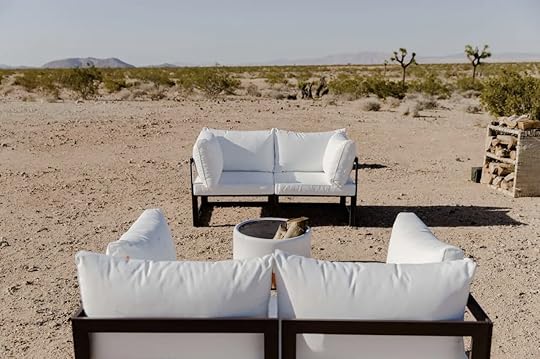
Photo: Airbnb
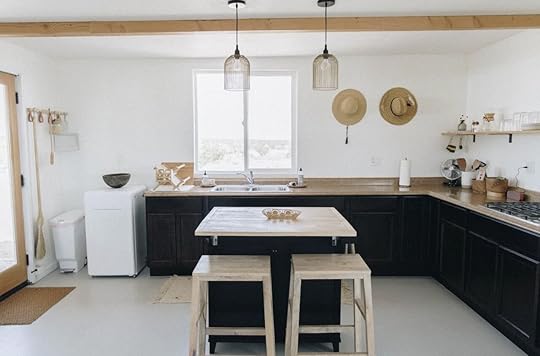
Photo: Airbnb

Photo: Airbnb
If you’re looking for a more intimate experience for you and your best friend or partner, El Rancho Joshua Tree is a small cabin that hosts two guests comfortably. This off-the-grid home is perfect for adventurers looking to enjoy the tranquility of the desert. The outdoor living room and outdoor pink shower are perfectly plush, and the beautiful modern kitchen is fully stocked for a home-cooked meal. Inside there’s another living room and a deep-soaking tub perfect for soaking the rest of the day away. You might be tempted to sleep in at this cozy home before heading back to the festival.
The vintage-meets-modern home and guesthouse
Traveling to Coachella? Check out Matador’s guides to the best places to stay in Southern California:
These beautiful San Diego Airbnbs put you close to the beach and downtown 9 dreamy oceanfront Airbnbs up and down the California coast 10 soulful beach Airbnbs for the perfect SoCal yoga retreat 12 very zen Joshua Tree Airbnbs perfect for families and groups

Photo: Airbnb

Photo: Airbnb

Photo: Airbnb

Photo: Airbnb
The High Desert Home is remarkable if you’ve decided to travel with a larger group to enjoy all Coachella offers. This two-bed, two-bath is fitted out with a guesthouse with its own bedroom, kitchen, and bathroom, getting you more bang for your buck. Enjoy Joshua Tree’s landscape with 360-degree views and the pool and jacuzzi. The home feels equally vintage and modern with crisp white and jewel-toned furniture, wood furnishings, and a beautiful stone fireplace as the centerpiece of the property.
The Green Haus with stunning views and wood built-in hot tub
Photo: Airbnb

Photo: Airbnb

Photo: Airbnb

Photo: Airbnb
This two-bed two-bath home has three beds, making it a comfortable choice to host a group of six. If you’re looking for a masterpiece, this home was designed by the Architects, Inverse Project, and is so stunning that it’s been featured in Vogue Travel Dwell Magazine and Architectural Digest. The crisp home is adorned with 180-degree desert views offering natural light and embraces the desert aesthetic inspired by the landscape. But the creme de la creme of the property has to be the hot tub that’s built into a cedar-wood deck offering the perfect relaxing escape from the hustle and bustle of the festival until you’re ready to tackle it again tomorrow.
 More like thisWhere to Stay12 Very Zen Joshua Tree Airbnbs Perfect for Families and Groups
More like thisWhere to Stay12 Very Zen Joshua Tree Airbnbs Perfect for Families and Groups
Matador Network's Blog
- Matador Network's profile
- 6 followers



